 Following reports yesterday of difficulty between Toshiba and Sony in agreeing on the Unified DVD format, bringing together HD-DVD and Blu-Ray, we’ve spoken to Sony and they have confirmed difficulties.
Following reports yesterday of difficulty between Toshiba and Sony in agreeing on the Unified DVD format, bringing together HD-DVD and Blu-Ray, we’ve spoken to Sony and they have confirmed difficulties.
Disc capacity
Blu-Ray, surprise, surprise uses a blue laser, as does HD-DVD. They didn’t just like blue lasers because it fits in with their name, or even that it’s their favorite colour, the shorter wavelength of the blue light, 405nm, (think of its position in the rainbow relative to the red, 650nm) allowed for higher density of their disks. Current CD and DVD media uses red lasers.
The difference in capacity of the two formats is pretty large. A single layer disc yields quite a difference – HD-DVD provides 15GB, and Blu-Ray 25GB.
Blu-Ray are claiming that their eight layer disks can hold 200GB of content, a considerable amount in anyone’s book. They’ve also told us they’re working on ten and twelve layer disks, pushing storage even higher to 300Gb. HD-DVD holds 30GB on their dual layer disks.
Why extra capacity is a sticking point
Many may wonder why 200GB is needed for a disk (not you, dear reader, I’m sure). Well while the storage requirements of HD content has a small part to do with it, the obvious use is to provide near-endless ‘extra’ material to go with the film on the disk (even if the purchaser isn’t interested in it). Less obviously, is placing material on the disk that is locked.
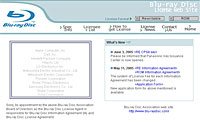 We think that Blu-Ray’s dogged pursuit for high capacity (possibly in the face of Unified DVD), and the fact that Sony are driving Blu-Ray is no coincidence.
We think that Blu-Ray’s dogged pursuit for high capacity (possibly in the face of Unified DVD), and the fact that Sony are driving Blu-Ray is no coincidence.
Sony, having learnt its lesson during the Betamax/VHS wars, now own a serious amount of content and the studios want to make more. We imagine that the content side of Sony’s business is pushing hard to extra capacity for commercial reasons.
Think about it – what do media companies want to do? Reduce the involvement of the middle man, or cut it out completely. If they are able to sell a disk with one accessible film on it, plus a number of films on it that are locked, they’ve reduced their distribution costs, and importantly, kept percentage paid to the retailer to a minimum. To access the extra films, the purchaser simply has to contact the media owner.
An important part of the Blu-Ray standard is its online capabilities, so the unlocking could be requested and paid for through the player, or via the phone for the die hards. The great thing, at least in the eyes on the media owner, is that the additional income generated is nearly all profit.
Difference in programming One thing that appears to have been missed by most commendations on Unified DVD is the world of difference in the programmability of HD-DVD and Blu-Ray. As a player supporting both standards isn’t realistic, one of the sides would have to change completely. This leads to considerable additional cost for the media creator, forcing them to effectively have to programme the whole disc twice.
 Cover layer thickness difference
Cover layer thickness difference
This is possibly the unbridgeable gap. Cover layer thickness – how close the information is written to the surface of the physical disc. Blu-Ray is 0.1mm and HD-DVD is 0.6mm. HD-DVD has plumbed for the 0.6mm, the same standard as current DVD’s. From our discussion, this appears to be an intractable difference.
The difference in layer thickness is one of the factors that makes manufacturing Blu-Ray discs more expensive, as the equipment used to create the disc has to be replaced.
Both sides have been busy gathering supporters of their own formats, in a not dissimilar way to two groups at school picking teams in the playground, trumpeting when another new chum joins their gang.
It will be a great shame if Unified DVD does fail. We all know what will happen – everyone suffers from the producers of the content to the consumer. At this time, it looks like we’re going to have to prepare for that.
HD-DVD
Blu-Ray
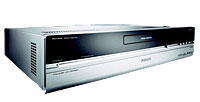 Philips has announced the Showline MCP 9350i, a media PC powered by Microsoft’s Windows XP Media Center Edition 2005 platform.
Philips has announced the Showline MCP 9350i, a media PC powered by Microsoft’s Windows XP Media Center Edition 2005 platform. There are two integrated tuners onboard letting sofa-reclining types watch one channel while recording another on the 250 GB hard drive or to CD or DVD.
There are two integrated tuners onboard letting sofa-reclining types watch one channel while recording another on the 250 GB hard drive or to CD or DVD.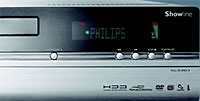 Philips’ Digital Natural Motion technology is employed to improve video quality and reduce stutter, with built in support for the UPnP protocol to allowing the unit to act as a media server for products in Philips’ Streamium range of media viewers.
Philips’ Digital Natural Motion technology is employed to improve video quality and reduce stutter, with built in support for the UPnP protocol to allowing the unit to act as a media server for products in Philips’ Streamium range of media viewers.  Following
Following  We think that Blu-Ray’s dogged pursuit for high capacity (possibly in the face of Unified DVD), and the fact that Sony are driving Blu-Ray is no coincidence.
We think that Blu-Ray’s dogged pursuit for high capacity (possibly in the face of Unified DVD), and the fact that Sony are driving Blu-Ray is no coincidence.  Cover layer thickness difference
Cover layer thickness difference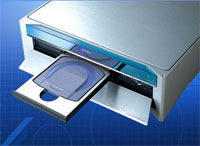 After years of throwing pans at each other, Sony and Toshiba are set to kiss and make up and develop a universal standard for next-generation DVDs, according to a report in the Nihon Keizai Shimbun business daily.
After years of throwing pans at each other, Sony and Toshiba are set to kiss and make up and develop a universal standard for next-generation DVDs, according to a report in the Nihon Keizai Shimbun business daily.  Two competing formats developed out of this technology, with Sony and Matsushita (Panasonic), introducing the Blu-ray standard in February 2002, with Toshiba and NEC Corp. following with the HD DVD standard.
Two competing formats developed out of this technology, with Sony and Matsushita (Panasonic), introducing the Blu-ray standard in February 2002, with Toshiba and NEC Corp. following with the HD DVD standard.  British Sky Broadcasting (BSkyB) has announced that it has signed a number of further contracts with technology and equipment suppliers ahead of the forthcoming launch of its High-Definition Television (HDTV) service.
British Sky Broadcasting (BSkyB) has announced that it has signed a number of further contracts with technology and equipment suppliers ahead of the forthcoming launch of its High-Definition Television (HDTV) service.  The studio will be fitted out with Tandberg Television HD video head-end with statistical multiplexing with Tandberg EN5990 HD MPEG-4 AVC enabling efficient bandwidth utilisation and high picture quality.
The studio will be fitted out with Tandberg Television HD video head-end with statistical multiplexing with Tandberg EN5990 HD MPEG-4 AVC enabling efficient bandwidth utilisation and high picture quality.  HDMI delivers the best possible picture quality to a HD display by maintaining an all-digital connection to DVI equipped displays possible using a suitable adapter cable.
HDMI delivers the best possible picture quality to a HD display by maintaining an all-digital connection to DVI equipped displays possible using a suitable adapter cable.  Pace Micro Technology, a cutting edge UK digital set-top box provider tasked with developing emerging technologies across all television platforms, has trumpeted the launch of a number of STB’s and PVR’s, including the Laguna DC551HD and DC 501 Chicago all-digital set-top box.
Pace Micro Technology, a cutting edge UK digital set-top box provider tasked with developing emerging technologies across all television platforms, has trumpeted the launch of a number of STB’s and PVR’s, including the Laguna DC551HD and DC 501 Chicago all-digital set-top box.  Pace is also offering the Tahoe DC775 HD-DVR, claiming it to be the most advanced high definition DVR for North America, and the first cable set-top box to offer features based on next generation silicon. Interestingly it offers a number of ways to save video content to the 160Gb hard drive – Standard Definition (SD), High Def (HD) and enhanced analogue. With multi-room video distribution and support for high-speed data connections for home computers, wireless routers and VoIP included you might be wondering what isn’t included.
Pace is also offering the Tahoe DC775 HD-DVR, claiming it to be the most advanced high definition DVR for North America, and the first cable set-top box to offer features based on next generation silicon. Interestingly it offers a number of ways to save video content to the 160Gb hard drive – Standard Definition (SD), High Def (HD) and enhanced analogue. With multi-room video distribution and support for high-speed data connections for home computers, wireless routers and VoIP included you might be wondering what isn’t included.  Pace Americas’ VP of Technology Chris Dinallo had clearly feasted on a diet of buzzwords before adding, “All-digital and digital simulcast are critical industry initiatives, and uniquely, Pace is proud to be the only set-top box provider that can support all-digital on both networks.”
Pace Americas’ VP of Technology Chris Dinallo had clearly feasted on a diet of buzzwords before adding, “All-digital and digital simulcast are critical industry initiatives, and uniquely, Pace is proud to be the only set-top box provider that can support all-digital on both networks.”  In a break with cinema-tradition, HDNet Movies viewers will be able to see Alex Gibney’s highly acclaimed documentary “Enron: The Smartest Guys in the Room” on the very same day the movie premieres in US theatres.
In a break with cinema-tradition, HDNet Movies viewers will be able to see Alex Gibney’s highly acclaimed documentary “Enron: The Smartest Guys in the Room” on the very same day the movie premieres in US theatres. 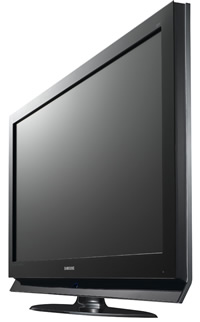 After getting the world very excited about their yet (if ever) to be produced 102″ plasma (PDP) screen, Samsung has today just announced the availability of a 82″ LCD TV. It’s for people who don’t live in houses with lounges (or media-consumption-arenas as they may become to be known) that are the size of the Albert Hall.
After getting the world very excited about their yet (if ever) to be produced 102″ plasma (PDP) screen, Samsung has today just announced the availability of a 82″ LCD TV. It’s for people who don’t live in houses with lounges (or media-consumption-arenas as they may become to be known) that are the size of the Albert Hall. 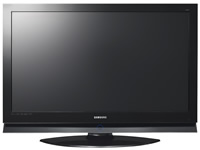 If you’re looking for a slightly more pedestrian use for it, it’s fitted with an HDMI interface, so all of that HDCP-protected content can be displayed on it.
If you’re looking for a slightly more pedestrian use for it, it’s fitted with an HDMI interface, so all of that HDCP-protected content can be displayed on it. 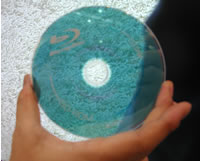 In a board meeting yesterday, Apple computers committed to join the Blu-ray Association and will occupy a seat on the main board.
In a board meeting yesterday, Apple computers committed to join the Blu-ray Association and will occupy a seat on the main board. 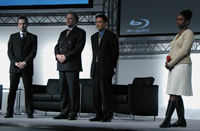 Blu-ray has been shipping in Japan now for quite some time. Sony’s BDZ-S77 (catchy name) was the first product to ship, and has been followed by other companies, some of which support the dual-layer 50Gb version.
Blu-ray has been shipping in Japan now for quite some time. Sony’s BDZ-S77 (catchy name) was the first product to ship, and has been followed by other companies, some of which support the dual-layer 50Gb version.